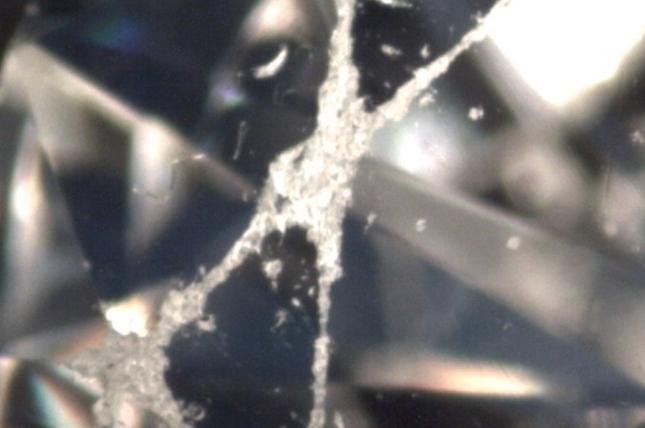Abrasion on a diamond refers to the process where the surface or facets of a diamond become worn, scratched, or damaged, typically from contact with other hard surfaces or rough handling. Abrasions can affect a diamond’s aesthetic appeal, its brilliance, and, in some cases, its structural integrity if left unchecked. These imperfections are different from internal inclusions and usually occur on the surface of the diamond.
Causes of Abrasion on a Diamond:
Physical Impact: Accidental bumps or knocks with hard surfaces, such as countertops or other jewelry, can cause abrasions to the diamond’s facets or edges.
Handling: Improper handling, such as rubbing the diamond against other surfaces, can cause gradual wear and tear. For example, a diamond ring worn daily may accumulate abrasions over time due to contact with clothing, other jewelry, or objects.
Improper Cleaning: Using abrasive cleaning materials or methods, like a rough cloth or harsh chemical cleaners, can scratch the surface of a diamond and lead to abrasions.
Wear and Tear Over Time: With long-term wear, diamonds, especially those in rings or other frequently worn jewelry, may experience gradual abrasion from continuous exposure to friction.
Types of Abrasion:
Facet Abrasion:
This occurs when the sharp edges of a diamond’s facets become worn down. Facet abrasions are usually visible under magnification (typically at 10x magnification using a jeweller’s loupe). The edges may appear rounded, dulled, or chipped.
Facet abrasions reduce the diamond’s brilliance and sparkle because they disrupt the way light reflects from the facets.
Culet Abrasion:
The culet is the small facet at the very bottom of the diamond. If this facet is damaged or worn down, it can lead to an abraded culet, making it look flattened or chipped.
An abraded culet can affect the diamond’s overall light performance and may also compromise its durability over time.
Girdle Abrasion:
The girdle is the outer edge of the diamond, where the top and bottom of the diamond meet. Abrasion to the girdle is often caused by the diamond rubbing against hard surfaces or being improperly set in jewelry.
If the girdle becomes abraded, it can affect the diamond’s symmetry and shape.
Surface Abrasion:
Surface abrasion occurs when the diamond’s external surface develops fine scratches. These are usually not as visible to the naked eye but can still affect the diamond’s appearance under magnification.
Impact of Abrasion on Diamond Appearance:
Reduced Brilliance:
When facets, culet, or edges become abraded, they may no longer reflect light in the same way, leading to less brilliance or sparkle. Diamonds rely on their sharp facets to reflect light and create the characteristic brilliance. Abrasions can disrupt this process.
Visual Imperfections:
Small chips, scratches, or worn areas caused by abrasions can be noticeable under magnification, and in some cases, even to the naked eye if the abrasion is severe enough. This can affect the diamond’s overall appeal.
Impact on Durability:
While diamonds are one of the hardest natural materials, abrasion can lead to further damage if the stone is exposed to continued rough conditions. For example, an abraded culet or facet edge could eventually become more vulnerable to chipping or breaking.
How to Identify Abrasion on a Diamond:
Magnification: The most effective way to identify abrasion on a diamond is through the use of a loupe (magnifying lens) at 10x magnification. Abraded surfaces will appear less sharp, with small chips, scratches, or dulling of the facet edges.
Grading Report: When diamonds are graded by gemological laboratories, like DCLA, the presence of abrasions may be noted if they are significant. Minor abrasions may not always be documented, as they might not impact the diamond’s overall grading or appearance.
Impact on Diamond Value:
Minor Abrasions: Small abrasions generally have a minimal effect on the value of the diamond, especially if they are not visible without magnification. However, they may be noted on a grading report as a sign of wear, which could slightly affect resale value.
Major Abrasions: Significant abrasions that affect the overall appearance of the diamond can lead to a reduction in value. The diamond’s brilliance and light performance will be diminished, which can reduce its visual appeal and market worth.
Repairing Abrasion on a Diamond:
Polishing:
In most cases, abrasions can be repaired through polishing. This involves carefully smoothing out the affected areas to restore the diamond’s sharp facets. This can improve its appearance and light reflection, but it may slightly alter the size or proportions of the diamond.
Re-cutting:
For more severe abrasions, the diamond may require re-cutting. This involves removing a small amount of material from the diamond to restore its symmetry and proportions. While this can improve the diamond’s appearance, it can result in a loss of carat weight.
Preventing Abrasion:
Proper Handling: To prevent abrasion, always handle the diamond with care. Avoid wearing it during activities that could expose it to rough surfaces or physical impacts (e.g., sports, heavy manual work).
Jewelry Care: Keep diamonds in protective settings to prevent them from coming into contact with other hard objects. Regular cleaning and inspection can also help maintain the diamond’s appearance.
Safe Storage: When not wearing your diamond, store it in a soft cloth pouch or jewelry box to avoid unnecessary friction or exposure to other jewelry that might cause abrasion.
Summary:
Abrasion on a diamond refers to surface wear, which can diminish the diamond’s brilliance and appearance over time.
Facet, culet, and girdle abrasions are the most common types, with facet abrasions having the most noticeable impact on brilliance.
DCLA grading reports can help identify and assess the severity of abrasions.
Abrasions can be repaired through polishing or re-cutting, although major abrasions may affect the diamond’s value and light performance.
